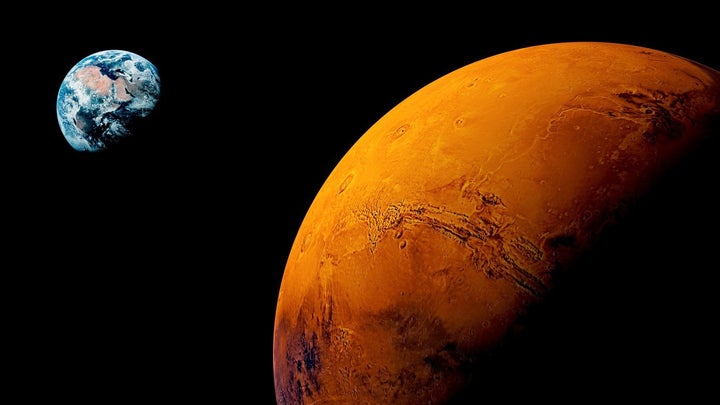
The Red Planet, in a not-to-scale view with far away Terra.
"Ecology and technology find a unity in space. ... As long as there is a safety valve of unexplored frontiers, then the creative, the aggressive, the exploitive urges of human beings can be channeled into long term possibilities and benefits. But if those frontiers close down and people begin to turn in upon themselves, that jeopardizes the democratic fabric."
Governor Jerry Brown
Space Day — California Museum of Science and Industry, Los Angeles
August 11, 1977
Another weekend, another set of Trump outrages.
Dissing his secretary of state for beginning back channel contacts with North Korea. As if Trump’s own sophomoric provocations have been anything but dramatically counter-productive.
Attacking Puerto Ricans upset about being left without power and comms, reduced to drinking creek water when they can get it, following the third historically powerful hurricane to strike American territory in the past several weeks.
Hey, what else would one expect of a climate change denier who began his political career on an overtly racist platform?
And then last night ... some white gun nut/retired accountant shoots hundreds of people at a country music show in Vegas. Madness. In a semi-deranged culture.
There is still a pretty good chance that America will survive the Joker presidency of the mad hatter DJ Trump. But let’s not kid ourselves that he is simply an anomaly. If anything, he is a symptom.
Only a profoundly unhealthy society would allow such an obviously erratic megalomaniac within hailing distance of winning the White House, much less actually elect him
And, despite his shrewd showmanship, the opposition party had to be pretty dysfunctional to allow Trump to pick up the votes of some who had earlier voted for Barack Obama.
Sure enough, Hillary and Bill Clinton and their strategists ran a presidential campaign, quite amazingly, which dropped state polling in favor of trendy across-the-board “analytics” which confirmed their fallacious bias that a demographic coalition which on a national level is still unique to Obama — hence the appellation “Obama coalition” — would turn out for a much older white establishmentarian.
I wrote the week before the election that Clinton was in big trouble in Pennsylvania and Michigan. Which is where she ended up losing.
For presidential elections are, contrary to the apparent belief of those who insisted that their statistical models proved Trump could never win, determined by garnering winner-take-all state electoral votes. Which is why you poll by state. Doh.
Small wonder that Elon Musk, one of the models for Robert J. Downey, Jr.’s great fictional icon Tony Stark/Iron Man, concluded even before the election that this society is in danger of not making it. And thus needs to commence getting itself off-world if humanity is to make it through the perilous passage of profound technological advance in a time of social division and cultural reaction.
The impresario of Tesla, the electric car leader which doubles as the leader in electric power storage (Musk is about to finish installation in South Australia of the world’s largest battery, 100 megawatts) and a major solar firm, is also of course the boss of SpaceX. The upstart space firm, which like its corporate sibling is also based in California, has long since elbowed its way into the ranks of the long-established aerospace giants contracting for NASA, now servicing the International Space Station with the first private space craft and taking the lead in the satellite business.
Impressive as all that is, Musk has long — almost certainly from his days as a youth reading Robert A. Heinlein, Isaac Asimov, and Arthur C. Clarke — been after even bigger game. In a word, Mars.
So when Musk, addressing the International Astronautical Congress Friday in Adelaide, Australia, rolled out his updated vision of a mission to Mars, it was no surprise.
Except that it was.
For Musk, who unveiled a sophisticated new rocket ship design, dubbed the, er, BFR, now says SpaceX will begin building “the first Mars ships” in “the next six to nine months.”
That is pretty darn specific. And it is no joke, as assessments in the New York Times, the Economist, and other sober-sided news outlets make clear.
And his plan beyond construction of the ships, is also pretty darn specific.
SpaceX intends to send to unmanned cargo ships to Mars in 2022 to deposit the makings of a colony and scout needed resources, to be followed in 2024 by two ships crewed by 100 explorers apiece and another two cargo ships to actually establish the first off-world settlement. (Because we are in a solar system in which astronomical bodies are in constant motion, rotating both on their own and around our sun, Earth is sometimes “just” 54 million kilometers from Mars and at other times 401 million kilometers distant. It is a two-year cycle.)
Well.
This is pretty darn “aspirational,” as Musk admitted. So those 2022 and 2024 dates might well slip. But the construction of the first ships is, in a fundamental sense, imminent. And the technology seems feasible.
In fact, Musk says he intends to use the newly-designed craft, which will supersede the existing Falcon rockets (named after the ‘Millennium Falcon’ of ‘Star Wars’) and Dragon capsules, both to return to the Moon and to establish rapid point-to-point passenger transportation on this world. Very rapid.
Traveling at up to 27,000 kilometers per hour, the new rocket ship, which of course is reusable and able to land on barges as is the case now with all SpaceX craft, Musk’s game-changing innovation, would be able to travel anywhere on Earth in less than an hour.
Unlike in space, on this planet, SpaceX will have to deal with many regulations and local concerns. So I’m not holding my breath before boarding the rocket ship from LA to London. But all that will help build anticipation for the Mars mission.

SpaceX chief Elon Musk seems to be emulating the fictional Delos D. Harriman of Robert A. Heinlein’s 1950 classic ‘The Man Who Sold the Moon’ as a would-be visionary space entrepreneur leading humanity outward bound into space.
Frankly, we need a Mars mission. In fact, as I’ve pointed out repeatedly, the U.S. government has spent/wasted more than enough on its predictably disastrous wars in Iraq and Afghanistan to fund several Mars-scale missions.
Going to the Moon was exciting. I was a kid when that happened, and I remember it all quite vividly. But then we stopped. That was a huge mistake.
Instead, we turned to a flying truck called the space shuttle that orbited the planet a lot and did some science missions and some black ops missions that generated nothing more than a medium buzz when they were not classified.
We did continue exploring the solar system and beyond, with the Hubble Space Telescope (named for the astronomer who discovered that the universe is accelerating its expansion in all directions) and with deep space missions run out of NASA’s Jet Propulsion Laboratory in the Los Angeles suburb of Pasadena. Which has provided us with tremendous amounts of knowledge. But that’s all done with technology. No people on the trip, no mass excitement.
As exciting as going to Luna (perhaps we should stop calling it the Moon, as many planets have moons, including the two around Mars) was, Mars is much more consequential. It’s a full-scale planet, one that even at its closest is vastly farther than Luna’s 250,000-mile distance. And it is a planet that, over time, can be terraformed into a future habitat for humanity.
That alone makes the mission valuable, for it points up how vulnerable we have made ourselves on this planet. Indeed, that is a point Musk, who is working hard against climate change, makes repeatedly.
We are seriously threatening human habitability of the Earth with our unsustainable development patterns leading to dangerous climate change. And our nuclear weapons, when coupled with our primitive social relations, provide a second existential threat. Jihadism, North Korea, these are existential threats only if we mismanage the threat. Climate change and nuclear weapons are real existential threats.
The second reason that Mars is very valuable is that it can channel our aggressive, expansionist instincts in constructive, aspirational ways, as that 40-year old Jerry Brown quote above makes clear. There are no intelligent beings on Mars. It can be our starter exploratory planet as we re-start the great journey “West.” In the New West, the endless frontier, the ultimate West of space.
The third reason is that it is something that can capture the collective imagination. We are turned far too inward, staring at our little phones in our palms, obsessing over social media, becoming trapped in our own social and political entropy, focused on what divides rather than unites.
By its nature, the Mars mission, as the first great return step of the ultimate Outward Bound exercise, is something that will require support and involvement from all kinds of people. It begins in California, a highly diverse place (Musk himself is an immigrant) of technologists and imagineers, but most if not all of the world will ultimately be involved.
The first two ships full of explorers/colonists are intended to be only the beginning. Over time, the sky, as the saying goes, is the limit.
Facebook comments are closed on this article.